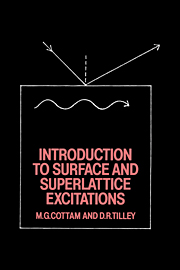Book contents
- Frontmatter
- Contents
- Preface
- 1 Introduction
- 2 Surface waves on elastic media and liquids
- 3 Surface magnons
- 4 Surface magnetostatic modes
- 5 Electronic surface states and dielectric functions
- 6 Surface polaritons
- 7 Layered structures and superlattices
- 8 Concluding remarks
- Appendix Green functions and linear response theory
- References
- Index
1 - Introduction
Published online by Cambridge University Press: 28 October 2009
- Frontmatter
- Contents
- Preface
- 1 Introduction
- 2 Surface waves on elastic media and liquids
- 3 Surface magnons
- 4 Surface magnetostatic modes
- 5 Electronic surface states and dielectric functions
- 6 Surface polaritons
- 7 Layered structures and superlattices
- 8 Concluding remarks
- Appendix Green functions and linear response theory
- References
- Index
Summary
In this book we are concerned with the ways in which surfaces or interfaces modify the properties of solids and liquids. Various different effects may be identified. First, there may be a modification to the equilibrium configuration in a medium close to a surface; this is known as surface reconstruction. For example, the atoms near to a surface may have a different crystallographic arrangement compared with those in the bulk, or they may be disordered. Another example is a ferromagnetic solid, in which the interactions between the magnetic moments at the surface may differ from those in the bulk, leading to a different value of the magnetisation. Clearly this type of effect may be temperature dependent, and it is particularly relevant when there is a phase transition (e.g. close to the Curie temperature in a ferromagnet). Second, the excitations within the system (such as the phonons in the lattice dynamics of a crystal or the magnons of a ferromagnet) are modified by a surface. In an infinite medium the bulk (or volume) excitations are characterised by an amplitude that varies in a wave-like fashion in three dimensions. When surfaces are present the bulk excitations are required to satisfy appropriate boundary conditions.
- Type
- Chapter
- Information
- Introduction to Surface and Superlattice Excitations , pp. 1 - 32Publisher: Cambridge University PressPrint publication year: 1989

